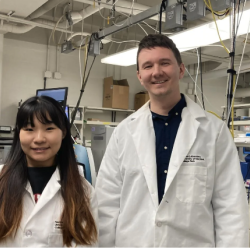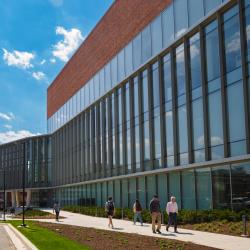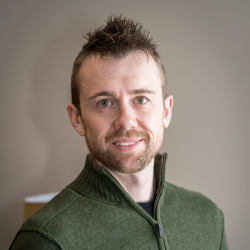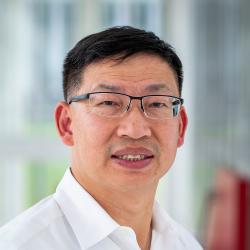Quantum Researcher Yu Liu Brings Laser Focus to UMD’s Department of Chemistry and Biochemistry
The laser cooling expert will launch two research projects on ultracold molecules in his lab in the new Chemistry Building.
Lasers are often misunderstood, according to chemical physicist Yu Liu.
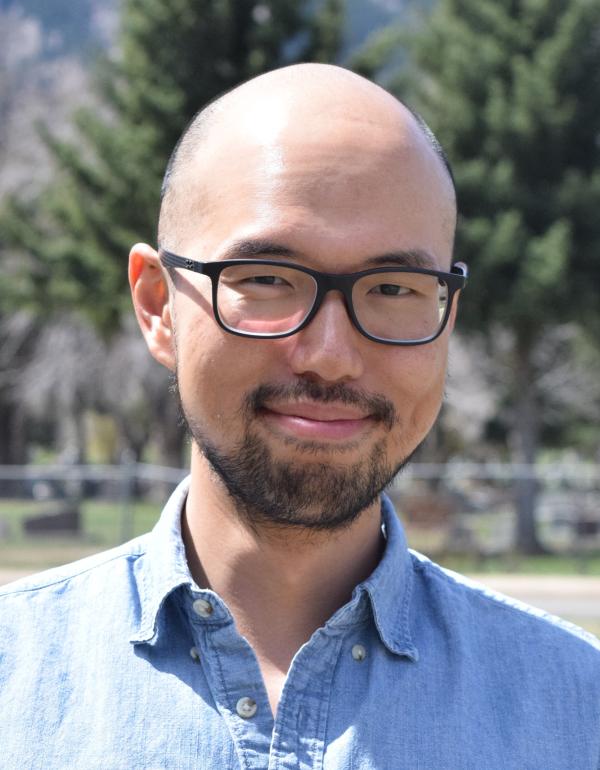
“People usually think of lasers as heating things up, but if you use the right frequency of lasers and target the right type of atoms, you can actually take energy away,” Liu explained.
This technique, known as laser cooling, is Liu’s specialty. He built his career on cooling molecules to “ultracold” temperatures—a mere thousandth or millionth of a degree above absolute zero—to observe their reactions in quantum chemistry’s version of slow motion. His discoveries and techniques provide an up-close look at molecules and the many quantum states they can adopt.
In January 2024, Liu will bring his unique brand of quantum precision to the University of Maryland as an assistant professor in the Department of Chemistry and Biochemistry. His lab will be located below ground in the new Chemistry Building—scheduled to open in the spring—to minimize vibration and electromagnetic and radio frequency interference.
Liu is excited to join an interdisciplinary team of quantum scientists at UMD, which is known as the “Capital of Quantum” due to its research output and proximity to industry and federal research labs. UMD’s reputation as one of the world’s top quantum research centers began in 2006 with a NIST partnership that yielded the establishment of the Joint Quantum Institute. Other quantum centers and institutes, including further partnerships with NIST, have followed.
“The chance to add to the quantum effort in UMD’s Department of Chemistry and Biochemistry—while also collaborating with the already amazing quantum researchers in the physics, electrical engineering and computer science departments—is especially exciting to me,” said Liu, who spent the last three years working on controlling the quantum states of single molecular ions as a postdoctoral researcher at the National Institute of Standards and Technology (NIST) in Boulder, Colorado.
Janice Reutt-Robey, chair of the Department of Chemistry and Biochemistry, described Liu’s research as “remarkable” and said it will unlock new opportunities in quantum science.
“His research has a depth and fearlessness that reflects his multidisciplinary training in physics and chemistry,” Reutt-Robey said. “He will work to expand the variety of chemical systems that are amenable to quantum science and accessible for technology. I look forward to the new quantum transduction mechanisms and quantum-state specific reactive phenomena that will emerge from his laboratory.”
Watching molecules dance
Liu has loved chemistry ever since he was a kid, but he decided to pursue physics in college to gain a deeper understanding of the rules that shape the universe. He earned a bachelor’s degree in physics from the University of Nevada, Las Vegas in 2014 and a Ph.D. in physics from Harvard University in 2020.
During his Ph.D., Liu studied under Kang-Kuen Ni, who Liu described as an ultracold molecule “pioneer” and the first person to show him the vast potential of applying physics techniques to chemistry problems. He enjoyed the work so much that he did his dissertation on the reaction dynamics of ultracold molecules—and he’s been pursuing it ever since.
“It combined several of my interests and seemed like the perfect project for me at the time,” Liu said. “Having done it for six years now, I’ve really developed a passion for it.”
Liu has already made significant contributions to his field of research. At Harvard, he co-led a 2020 study in the journal Nature Physics on the ability of laser cooling to extend the life of the “complex,” a state that occurs in the middle of a chemical reaction before the reactants turn into their final products. This enabled researchers to observe the behavior of molecules in the span of a microsecond—a much slower pace than they would witness at room temperature.
“When you have two molecules colliding in a typical chemical reaction, they're going to stick together for about one vibrational rotational period and then they separate,” Liu explained. “But in the reaction I was looking at, they come together, vibrate millions of times and keep dancing around each other before they separate.”
The research team discovered a drawback, however: In their prolonged state, the molecules became “excited” by the light of the laser used to confine them, causing them to heat up. These findings helped crack the mystery of ultracold molecule loss that previously plagued researchers, improving the usefulness of ultracold molecules as a platform for quantum science and technology.
Liu was also instrumental in developing a technique to observe the quantum states of chemical reaction products. In a paper published in the journal Nature in 2021, he used the technique to study chemical reactions between molecules confined in an optical trap at temperatures close to absolute zero.
“By cooling things down, we’re controlling the number of states that these chemical reactions can occupy, and that makes it possible to look at them in extreme detail,” Liu said. “We can tell you how likely it is that a reaction will go to any of these product quantum states—for example, a 10% probability of two products coming out of the reaction rotating in a particular way.”
Liu Lab’s projects
Once Liu gets settled at UMD, his lab will launch two main research projects. The first will explore chemical reactions involving lithium, which is “one of the few chemical species where you can use existing techniques to get to ultralow temperatures,” according to Liu.
Lithium’s light weight makes it an outlier in this field of research because most of the molecules that have been brought to ultralow temperatures belong to heavier chemical species. However, its weight also allows theorists to calculate the behaviors that occur during chemical reactions with much higher precision than those of heavier atoms.
“Precise calculation, combined with accurate experimental measurements enabled by ultralow temperatures, is a recipe for better understanding the quantum dynamics of chemical reactions,” Liu explained. “I was inspired to pursue this project at UMD following a conversation with our very own Millard Alexander, a renowned theorist.”
Liu’s second project will use an ion-neutral hybrid trap to conduct spectroscopy of chemical species in unprecedented resolution. Because neutral atoms are a lot harder to cool than ions, a hybrid trap can be used to ensnare a compound that contains both an ion and an atom. Once the compound is cooled, the atom can be separated through photodissociation and studied in cold conditions that are ideal for new discoveries.
“Essentially we’re putting a neutral inside a container that’s easy to cool and manipulate, and once we are done cooling the container, we peel off the wrapper and we review the cold neutral fragment that we’re actually interested in studying,” Liu said.
One of the main goals of this project is to broaden the range of chemical species that can be brought to ultralow temperatures, with Liu adding that chemistry is “most fun when we’re able to play with different species.”
At the end of the day, Liu is working toward a deeper understanding of quantum chemistry, bit by bit and species by species.
“My long-term research passion is to develop more detailed understandings of how chemical reactions work,” Liu said. “When atoms in a molecule interact with each other during a chemical reaction, they play by the rules of quantum mechanics instead of Newtonian physics. My goal is to understand this level, and the way to do that is to look at chemistry—one quantum state at a time.”
Written by Emily Nunez



